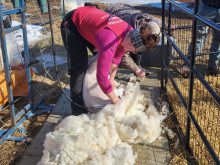BANFF, Alta. – Australian farmers are dealing with the worst weed resistance problems in the world, but only a few have adopted extensive measures to manage the problem.
Others have become desperate and are forced to try whatever extension agronomists such as Steve Sutherland suggest.
“In western Australia, resistance is so severe farmers are forced to do things they would never think of,” said Sutherland at a meeting of the expert committee on weeds.
Taking an integrated approach to weed control is a foreign idea to many, but some headway is being made using demonstration plots with co-operating farmers and other education programs.
Read Also

Charges laid after cattle theft
Saskatchewan RCMP lay two charges against a man after six cattle went missing.
Herbicide resistance affects 22 weeds in Australia including wild oats, wild radish and Indian hedge mustard.
The most challenging is annual ryegrass. It is resistant to six forms of chemicals including eight documented cases of glyphosate resistance. This plant was originally seeded in pastures across the wheat belt.
In New South Wales where Sutherland works, producers grow lupin and wheat rotations in a continuous cropping system.
They have been encouraged to break the weed cycle by trying different rotations including seeding land to pasture. Adoption has been a slow process. Farmers reject integrated weed management as long as they have some herbicides that work.
Integrated management involves extra costs, planning and time, but does not improve crop yields.
Extension people including Sutherland advise farmers to rotate their chemicals to ensure they try herbicides with a new method of killing weeds.
Another practice is to burn chaff windrows after harvest. An attachment on the combine dumps the chaff and seeds into a narrow trail. Farmers may spray the trail and then burn it. Some pull a trailer behind the combine and dump the chaff into a pile and then burn it. Others sell the chaff to local feedlots.
Another solution is sowing land back to grass. This does not appeal to everyone, especially when livestock prices are low.
However, about a third of the fields have been seeded to pasture and more will go to permanent cover if resistance grows worse.
On grass-seeded fields, hay is cut for silage. This controls wild oats because the plants never set seeds.
Farmers also turn sheep into these pastures. However, researchers have found about five percent of weed seeds remain viable after passing through the animals.

















